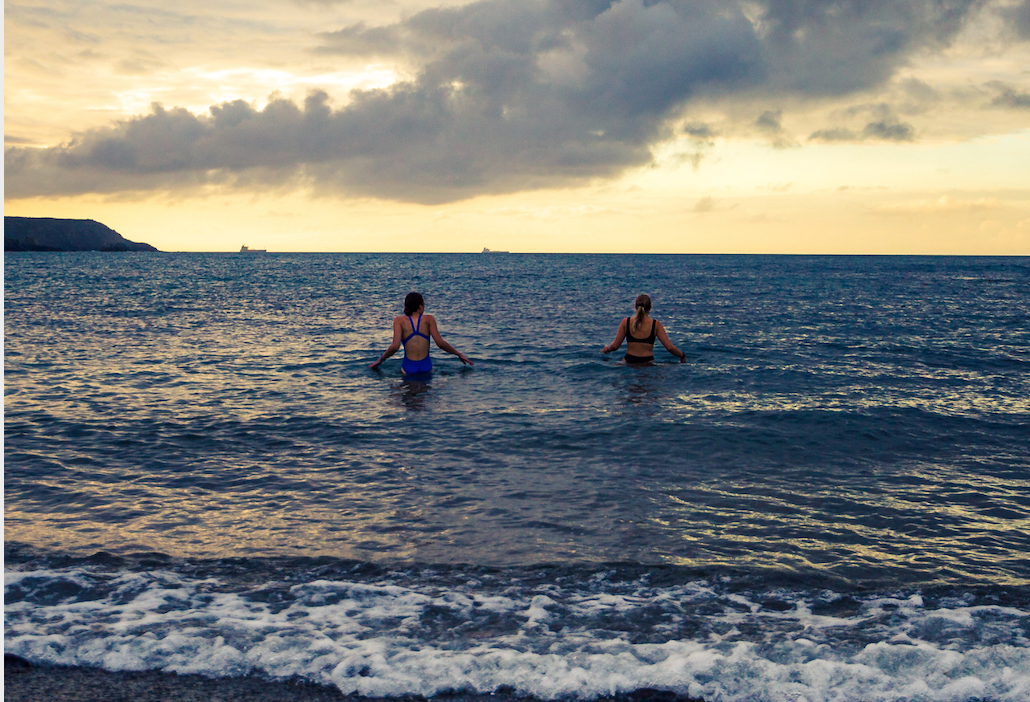A Beginner’s Guide to Wild Swimming
Words by Lydia Paleschi
For many, wild swimming is a way of life, but it all starts with that first swim. If you have even the slightest interest in entering the water, we highly recommend that you give it a go. There’s a well-coined phrase by all wild swimmers – and the reason it’s easier to get in the more you go – which is that “you never regret a swim!” I can confidently assure you that this is one hundred percent true.
This blog is for anyone with the slightest interest in getting in who hasn’t before and also for people that are considering swimming through winter who may not have done so in previous years. It is our intention to make it as easy as possible to welcome more people into the wild swimming community so that they can experience the huge number of benefits associated with it and join us in experiencing the Great Outdoors. You don’t have to be the best swimmer, or have a great deal of kit. The only prerequisite is that you need to have some swimming ability.
This detailed step-by-step guide will provide you with all of the necessary information to go for a wild swim, whether in Cornwall or beyond. By following these steps you should be able to achieve the perfect wild swimming experience which is both safe and fun.
With over 300 beaches in Cornwall, it shouldn’t be hard to find a location to swim from.
1. Choose a location
With over 300 beaches in Cornwall, a wonderful selection of tidal pools and a couple of spring fed quarries to choose from it shouldn’t be hard to find a location to swim from. It’s probably best to choose somewhere lifeguarded and close to home for your first swim, to make the process as easy as possible. It’s also likely that you will have some local knowledge of your nearest swimming spots, which will make it safer. If not, feel free to ask someone. You can also check out our book A Guide to Wild Swimming in Cornwall, which includes site specific information including on safety and tides.
2. Safety
Unlike a swimming pool, the ocean is a large, uncontrolled environment, and therefore the preparation for any swim requires careful thought and consideration of all the potential risks. Conditions change all the time, so it is important to consider safety each and every time you go for a swim, even if you’ve been to that location before. Things to consider include tides, swell, entry and exit points and knowing your limits. It’s also worth checking for pollution using the Safer Seas Service app created by Surfers Against Sewage. You can find more information on safety via the Wild Swimming Cornwall website and the RNLI website. You can check conditions and access live website footage of many of Cornwall’s beaches using the Magic Seaweed website.
3. Find a group or a friend to go with
Not only is it safer, but it is also really fun to go swimming with others. It makes you less likely to back out and is a real good motivator. If you’re nervous about swimming, there are a number of groups you can go to for coaching. Alternatively, there are plenty of free wild swimming groups that you can join in all areas of Cornwall and the Isles of Scilly. You can find an interactive map of Cornwall’s swimming groups here, or check out our blog on how to pick a swimming group.
Not only is it safer, but it’s also really fun going wild swimming with others.
4. Prepare your kit
The kit that you take with you to swim will depend on how brave you are feeling. A towel and warm clothes for afterwards are a necessity, as are a hat and warm socks in the winter. It’s also worth wearing ear plugs to protect your ear drums and prevent surfer’s ear. However, it's a personal choice as to whether you want to go in with a wetsuit or without one (also known as “skins”). We prefer to go in without a wetsuit unless we’re swimming long distances. However, you may find that a wetsuit gives you extra motivation to get in for your first time. If you’re nervous about swimming, wearing goggles could be a good way to make you feel safer. You may also wish to consider wearing booties if you’re put off by seaweed or walking across sand or rocks.
5. Arrive at your chosen location
Once you arrive at your location, it’s important to do another risk assessment before getting in. Decide on where your entry and exit points are going to be and then it’s time to strip off!
6. Expect resistance
The first time you go for a wild swim (especially during the colder months of the year) you are guaranteed to experience resistance. Your brain will provide you with a hundred reasons why you shouldn’t get in and convince you it will be better to just go for a walk or go home. It’s important for you to expect and overcome this. Part of the reason wild swimming is so good for you is because you learn to control your mind by overcoming the mental resistance you experience at the water’s edge. By choosing to put your body into cold water, you are acknowledging fear and choosing to confront it. As time goes on and you swim more frequently, you will experience less and less resistance until you find you hardly think about it. To learn more about the psychology behind resistance and how to overcome it, read our blog by psychotherapist and ecotherapy retreat leader Ben Ford.
Expect resistance as you ease yourself into the water. This was a particularly cold 5am swim on the Lizard Peninsula.
7. Getting in
For your first swim, and at least until you know your limits, it is important to gently ease yourself into the water. This will be a battle of wills between you and the resistance, but persevere and you will reap the rewards. If you enter the water too quickly, you are at a greater risk of experiencing cold water shock – this occurs when our skin experiences a sharp decline in temperature and our blood vessels constrict, causing gasping and an increased heart rate. Cold water shock occurs at different temperatures for different people, so it is important to know your limits before getting in quickly. If you’re more experienced and wish to jump in, you should only do so if someone has checked the water is deep enough and that there are no hidden obstacles.
8. The swim
Once you’re in, it will take several minutes before your body adjusts to the cold. Splash some water on your face before diving under so that you can acclimatise more easily. If you start to gasp, focus on your breath and take deep exhalations in and out. As you adjust to the cold you will feel a surge of endorphins as your mind and body begin to relax. Remember, you will never feel more alive and present than in these moments. Your skin will begin to tingle and you will experience a sense of joy and calm. Make sure you stay close to the shoreline, swimming parallel to the beach and don’t forget to take in the views and natural surroundings.
Check out our blog what happens to the body in cold water with Dr Heather Massey for more information on these physiological responses.
As you adjust to the cold you will feel a surge of endorphins as your mind and body begin to relax.
9. Getting out
Once you have acclimatised and are experiencing the invigoration of being outdoors and immersed in the cold, it’s likely you won’t want to rush out of the water. However, it’s important that you don’t stay in for too long. It is a common mistake for people to spend too much time in the water during their first swim, which leaves them feeling drained and unwell afterwards. Just five minutes is plenty for your first attempt and you can build it up from there as you begin to swim more often. If you feel unwell or begin to shiver, leave the water immediately and warm up as this may be a sign that your core temperature has dropped.
10. Warm up
Because our bodies have adjusted to the cold and we are experiencing a natural high from the release of endorphins by the end of our swim, it’s easy to forget how cold it is. However, our bodies continue to cool down for up to twenty minutes after get out of the water because of the cooler blood being pumped around our bodies. Therefore, it is really important to get dry and into warm clothes as soon as we get out. Failure to do so could result in our core temperatures dropping and increases the risk of hypothermia. If you wear a swimming hat, take this off last as you lose the most temperature from your extremities (head and feet). If you’re not wearing one, put a warm hat on as soon as possible. A pair of warm socks can make all the difference and your warmest jumper is a good move too. If you want the ultimate warming up experience take a flask with a hot drink with you, wrap your jumper around it whilst you swim and then when you get out you will have a warm drink and a warm jumper to enjoy.
It is really important to get dry and into warm clothes as soon as we get out.
11. Reward yourself
Achieving your first wild swim (and any subsequent wild swims) is an achievement to be proud of. This feeling and the benefits of spending time outside in nature will stick with you for the rest of your day. Reward yourself with a snack (my personal preference is cake) and a hot drink whilst soaking up the satisfaction.
Summary
To summarise, here is a checklist of our beginners guide to wild swimming:
Choose your location
Check tide times, swell charts, pollution and other safety aspects
Find a group or a friend to go with
Pack your swimwear, plus a towel and plenty of warm clothes for afterwards
Arrive at your chosen location
Expect resistance and train yourself to overcome it
Get in!
Enjoy your swim
Don’t stay in for too long
Get changed and warm up immediately after getting out
Let us know in the comments below if you have any tips for beginner wild swimmers!
Don’t forget to check out A Guide to Wild Swimming in Cornwall for the best spots in Cornwall!
If you enjoyed this blog, why not sign up to our newsletter?
If you know someone else who would enjoy it, please share it with them via email or social media.






